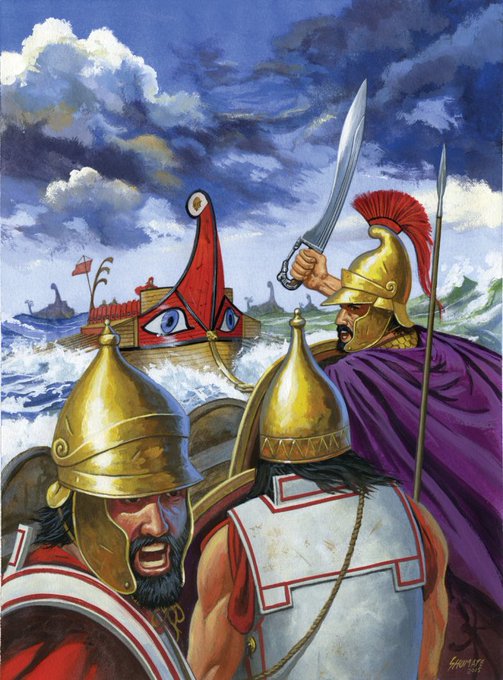hellenisticのTwitterイラスト検索結果。 77 件中 4ページ目
The sculpture (c. 2nd cent BCE/1st cent CE) may be Hellenistic or a later copy. It highlights the grief of Trojan priest, Laocoön, as two killer serpents rise from the sea after he rejects the notion of the Trojan horse as a gift
1.Vatican Museum2.Alessandro Allori 3.Marco Dente
In 276 BC the Hellenistic king Pyrrhus famously remarked upon departing Sicily, 'Oh what a wrestling ground we are leaving for the Carthaginians and Romans to fight over.' He was proved right when, 12 years later, the First Punic War erupted.
Artwork by © Johnny Shumate.
Statue of #Eros Sleeping, Hellenistic or Augustan 3rd century BC-1st century AD. Medium: Bronze.
In 276 BC the Hellenistic king Pyrrhus famously remarked upon departing Sicily, 'Oh what a wrestling ground we are leaving for the Carthaginians and Romans to fight over.' He was proved right when, 12 years later, the First Punic War erupted
Artwork by © Johnny Shumate
In 276 BC the Hellenistic king Pyrrhus famously remarked upon departing Sicily, 'Oh what a wrestling ground we are leaving for the Carthaginians and Romans to fight over.' He was proved right when, 12 years later, the First Punic War erupted.
Artwork by © Johnny Shumate
A 2-minute sketch of my oc, Julien!
He's a small little Greek boy who adores Greek gods/goddesses- since he grew up to be Hellenistic.
In 276 BC the Hellenistic king Pyrrhus remarked upon departing Sicily, 'Oh what a wrestling ground we are leaving for the Carthaginians and Romans to fight over.' He was proved right when, 12 years later, the First Punic War erupted
Artwork by © Johnny Shumate
Wounded shepherd– A4 Pastel on Paper 💫
An illustration inspired by The Dying Gaul, an Ancient Roman marble copy of a lost Hellenistic sculpture.
https://t.co/HbmRZ7MY0n
#drawing #draw #illustration #artgallery #painting
#artwork #art
Hellenistic temple’s palmettes situated on the top of the temple, (280-150 BC), Failaka Island, Kuwait
Nike, Greek goddess of victory, based on famous Hellenistic sculpture found in Samothrace. Done in #arq4 palette.
@Pixel_Dailies #pixel_dailies #GreekGod #pixelart #aseprite
King Pyrrhus of Epirus against the Romans (280-275BC). Hellenistic phalanx & war elephants against (early) legions.
ignoring every aspect of the occult au thats got me fuct up to yell about hellenistic witch bebe. god bless this au
Another ko-fi reward! Here is 'The Chios Head', marble from Paros, Greek Hellenistic, 3rd to 2nd centuries BC. Currently housed at the #museumoffineartsboston To receive a similar ancient doodle, support DStoreyStudio: https://t.co/juiYnPCV7x
#AncientArtWeek
Statue of an Ethiopian Youth
Hellenistic Greece (c. 3rd-2nd Century B.C.E.)
Bronze, 18.29 cm.
The Metropolitan Museum of Art
https://t.co/sQmpwHEMCi
Picasso (1921) - the genius of the Spaniard was to question everything. Here he examines the Hellenistic tradition whilst exploring the idea of monumentality #artwork
#WonderWoman for the drawing class! We were supposed to use a hellenistic statue as a reference for a comic book character. #dccomics










































